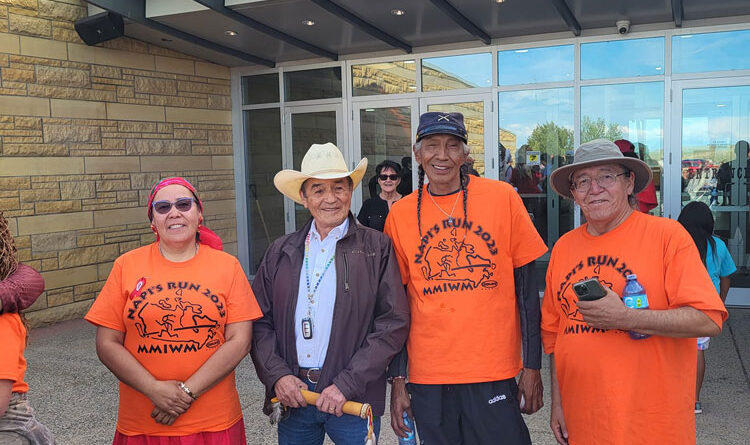Napi’s Run passes through Siksika Nation
By John Watson Local Journalism Initiative Reporter

Photo Courtesy of Ramona Big Head
Siksika Nation recently welcomed and honoured Johnny Bare Shin Bone at the Blackfoot Crossing Historical Park as he continued to run across Canada, raising awareness for Missing and Murdered Indigenous Women and Men (MMIWM).
The endeavor, being referred to as Napi’s Run – translated means “Old Man’s Run,” began April 12 at the Mile 0 site in St. John’s, N.L.
“Napi’s Run was really started with my uncle John … he is a marathon runner and he is always running races. A couple years ago, he came to see me and said he wanted to run across Canada for missing and murdered indigenous women and men, and for Mother Earth,” said Ramona Big Head, who is coordinating Napi’s Run. “At that time, it was during COVID-19, so I knew we were going to have to wait a bit for that to happen … at the beginning of this year, he and I and my sister, we all went to St. John’s, N.L. and then started planning.”
Bighead added Bare Shin Bone was also inspired to begin the run by Terry Fox, who began his Marathon of Hope on April 12, 1980.
June 21 marked day 71 of the run, as the team passed through Siksika Nation. Their goal was to reach Victoria, B.C. by July 5.
“This is a relay, unlike Terry Fox who ran every day himself. This is a group of runners who started back in April. Of the original runners who started with us, I think we have five of them still with the run,” said Bighead. “Running a relay with eight to 10 runners a day, we are able to cover about 85 to 100 km a day, and that is kind of how we do it.”
As Bare Shin Bone and the team were passing through Siksika Nation, they stopped at the Blackfoot Crossing Historical Park, as a ceremony had been set up to welcome their convoy and honour him with a headdress.
“He (Bare Shin Bone) was just overcome with emotion. He is one of our leaders in our own ceremonial way, he guides us and he grounds us at times,” said Bighead. “On June 21, we made it to Blackfoot Crossing and there was at least 200 people out there who greeted us in traditional ways, singing honour songs as we ran in, and my uncle was honoured with a headdress, which is one of the highest honours he could get.”
Bighead added many families have requested the relay team to dedicate legs of the journey to particular missing persons, groups, or families who have been impacted, for example, by fentanyl overdoses, and those who have lost their lives to suicide.
Though the run is not being advertised as a fundraiser, the team was accepting donations in order to support their journey. Additionally, anyone both Indigenous and not was invited to participate in the relay.
More information regarding Napi’s Run, including daily updates is available via the team’s Facebook page.
